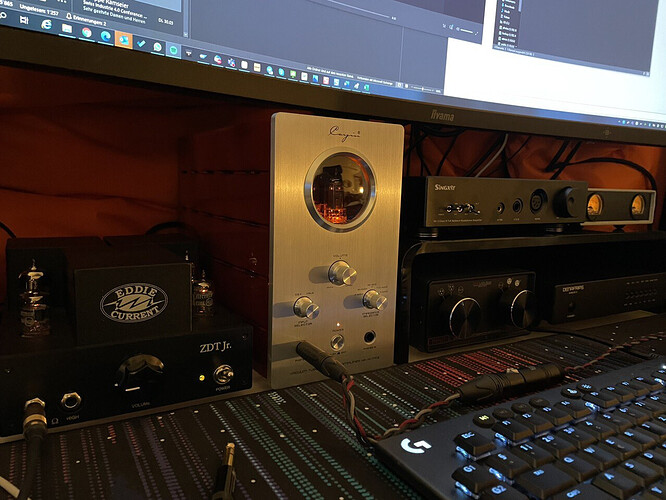It’s not a big concern, the singxer is not really all that bad, that softness and how it takes the edge off things isn’t overdone and is generally not going to bother people looking for this type of sound
analogue sound as i understand it?
really nice to be able to bounce these things off of someone much more experienced than i to see if im in line with how to describe audio properly, i think it would be interesting if there was a locked Category regarding this, a guide type thing to technically talk audio properly because there is definitely a lot of colorful labels on the different aspects of sound which don’t seem to serve anyone, not that there is a lot of that, at least here. I know it would help me out, and it would be super nice having it all explained in a single post, it may even serve newcomers
i’ve heard that the singxer has a DIP implementation, if anyone care to, seeing a pic of the bottom as well as a generalized idea on what the switches do would be much appreciated
I think the switches are for gain setting.
Yep the 4 switches are the gain of the amp. All to high or all to low. No mixing.
btw: A90 sold. Now it’s Eddie Current ZDT Jr, Cayin HA-1A MK2 and Singxer. I think that means I’m done with ultra liniear amps ![]()
4 dip switches two modes???
… … …
hekk?
anyhow, thanks for the followup! How is the Sinxer compared to A90?
would it be correct in saying that the A90 is more delta sigma sounding and that the Sinxer is more analogue sounding? from what i’ve been reading that’s been my takeaway.
I always imagined the A90 as an overpriced 789 but idk
I too have the ARES2, what DAC did you enjoy the most with the Sinxer? Really appreciate if you could elaborate further, if you don’t feel like it thats cool to! Thanks anyways
and also, what are you looking at for a replacement?
oh yeah and what headphones did you like the SA-1 with?
It’s a balanced amp which means 2 amp modules per channel. So 4 amp modules total. One switch for each.
Could you compare this amp to the LP?
The sa-1? It depends on the tubes you have in, but overall right off the bat the plat has more accurate timbre and a more spatially involving presentation (feels larger, more space overall, still accurate in that space), similar detail retrieval although I think the plat has better microdetail, the plat sounds a bit more impactful but the singxer feels a slight bit tighter, both are more warmer fuller leaning but the plat has a stronger house sound overall so a bit more colored sounding and the plat is a bit more forward than the singxer, the singxer is smoother than the plat, for speed wise the singxer feels quicker on it’s feet. Dynamically I find the plat more impressive, and I also think the plat has better texture in the low end than the singxer. Generally both are decently forgiving of source gear but do scale, also with iems and very sensitive headphones the singxer has a lower noise floor. Also the singxer has the obious advantage of having gain settings which the plat does not. Overall I do prefer the plat as I think it’s more spatially impressive and a more enjoyable listen but it depends on the headphones you have
professor m0n
hi Shane hope all is well!
so im going through the thread again in anticipation of the arrival of an SA-1 and saw you mentioned it as being a class a/b amp, not sure if you know the innards of that architecturally and functionally but if you do i wanted to ask if there is such a thing as getting an a/b class amp to mostly run in class a mode?
which may be a bit of a silly question but i really have zero knowledge on it
i ask because everyone always talks about class A being just a better sound compared to other solutions
I don’t think you can choose it, but with an amp like SA1 or Asgard 3 which is class A/B with bias towards class A I think it is most likely to stay in class A at lower volume
I am far from an expert, I just read a lot. 
There are a lot of A/B amps because they work so well. Most of their time spent operating in Class A until they are pushed hard and then they can go into B mode. There are guys here that can explain much it better than me, technically.
A/B really can be the best of both worlds though. Great sound, lots of power and no extreme heat.
interesting, really interesting subject. i guess if i could go out of my way to make sure it ran mostly in class A i would do that for the reason that people talk about it sounding different with different gain settings or if its that it’s rather the low z or high z or a combination of both but i remember people talking about them getting different sounds from it, but this may also just simply be that the requirments of their headphones being met and not with the different modes and not necesarily wether or not it’s running in a or b but i’d love to find the answer to that
Enjoy ![]()
seems to me that with a/b you’re essentially guaranteeing better sound with easier to drive headphones if the a/b implementation is good so not to push it into class b, thats going off by the that the general concencus is that class a just sounds better in general, i’m sure there are exceptions
oh hekk now you’ve done it Shane. hf reading dry material, depends on who you are i guess, thats nothing on you Maze, not trying to dismiss your post or anything im sure it’s a good source.
It is not that dry.
The TL;DR is: At the 0 Crossing in a Class AB amplifier, you loose 0.7V to drop across the diodes (without the diodes, you have a Class B, with the horrible crossover distortion that entails).
The Biasing essentially pulls the signal to be 0.7V higher (or lower) so on 0-crossing, the other transistor instantly takes over.
In other words:
The bias voltage sets during how much of the input signal the amplifying element is active.


